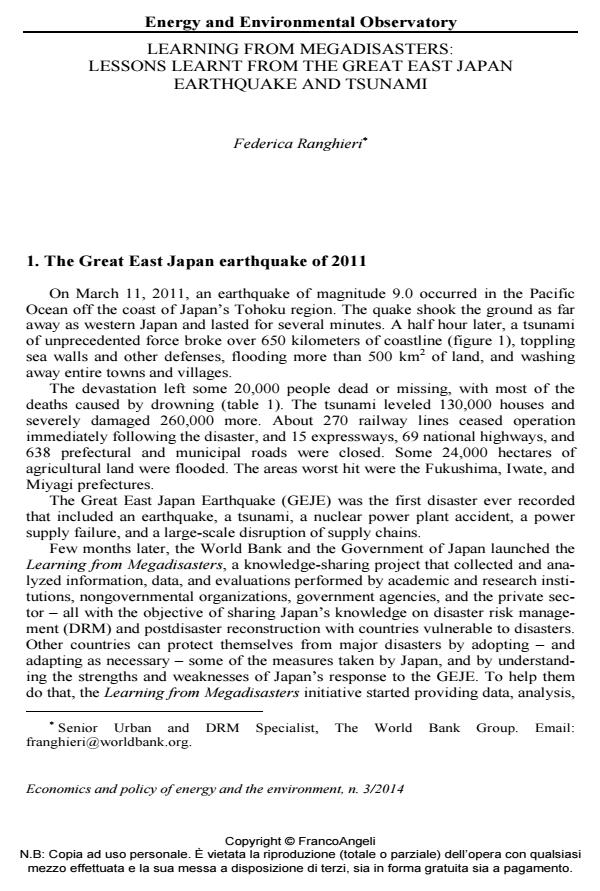Learning from megadisasters: lessons learnt from the Great East Japan earthquake and tsunami
Journal title ECONOMICS AND POLICY OF ENERGY AND THE ENVIRONMENT
Author/s Federica Ranghieri
Publishing Year 2015 Issue 2014/3
Language English Pages 13 P. 5-17 File size 1076 KB
DOI 10.3280/EFE2014-003001
DOI is like a bar code for intellectual property: to have more infomation
click here
Below, you can see the article first page
If you want to buy this article in PDF format, you can do it, following the instructions to buy download credits

FrancoAngeli is member of Publishers International Linking Association, Inc (PILA), a not-for-profit association which run the CrossRef service enabling links to and from online scholarly content.
On March 11, 2011, an earthquake of magnitude 9.0 occurred in the Pacific Ocean off the coast of Japan’s Tohoku region. The quake shook the ground as far away as western Japan and lasted for several minutes. A half hour later, a tsunami of unprecedented force broke over 650 kilometers of coastline, toppling sea walls and other defenses, flooding more than 500 km2 of land, and washing away entire towns and villages. The devastation left around 20,000 people dead or missing, with most of the deaths caused by drowning. The tsunami leveled 130,000 houses and severely damaged 260,000 more. The areas worst hit were the Fukushima, Iwate, and Miyagi prefectures. This article investigates the ability of the Japan disaster risk management (DRM) system to cope with such megadisaster and to prevent even stronger impacts. Based on a project started in 2011 and ended in 2014, sponsored by the Government of Japan and the World Bank, which collected and analyzed information, data, and evaluations performed by academic institutions, nongovernmental organizations, government agencies, and the private sector, the article explains what worked and what worked less well on March 11, all with the objective of sharing Japan’s knowledge on disaster risk management (DRM) and postdisaster reconstruction with countries vulnerable to disasters.
Keywords: Disaster risk management, risk assessment, megadisasters
Jel codes: Q54, Q58
- Integrating renewable energy sources into electricity markets: Power system operation, resource adequacy and market design Umberto Monarca, Ernesto Cassetta, Alessandro Sarra, Cesare Pozzi, in ECONOMICS AND POLICY OF ENERGY AND THE ENVIRONMENT 2/2016 pp.149
DOI: 10.3280/EFE2015-002010 - The cost of failing to prevent gas supply interruption: A CGE assessment for Peru Carlos Adriàn Romero, Omar Osvaldo Chisari, Leonardo Javier Mastronardi, Arturo Leonardo Vásquez Cordano, in ECONOMICS AND POLICY OF ENERGY AND THE ENVIRONMENT 2/2016 pp.131
DOI: 10.3280/EFE2015-002009 - Modeling search and rescue, medical disaster team response and transportation of patients in Ishinomaki city after tsunami disaster Erick Mas, Shinichi Egawa M.D., Hiroyuki Sasaki M.D., Shunichi Koshimura, A. Rahman, Y. Idris, H.A. Haridhi, Muksin, E. Meilianda, T. Musa, I. Rusydy, A. Suppasri, E. Mas, A. Opdyke, in E3S Web of Conferences /2022 pp.05001
DOI: 10.1051/e3sconf/202234005001
Federica Ranghieri, Learning from megadisasters: lessons learnt from the Great East Japan earthquake and tsunami in "ECONOMICS AND POLICY OF ENERGY AND THE ENVIRONMENT" 3/2014, pp 5-17, DOI: 10.3280/EFE2014-003001